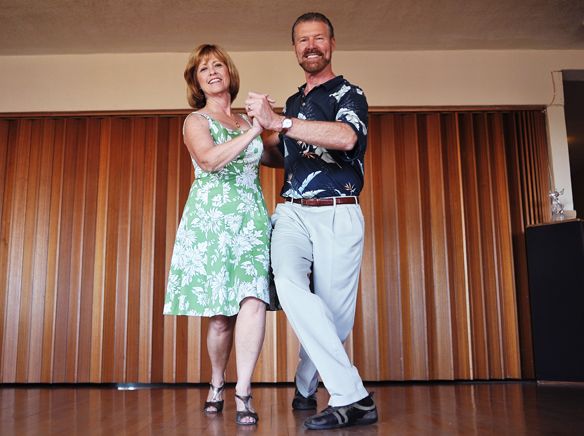Mac Vitties has been a landmark in the ballroom dance scene for morethan 50 years
In 1959, Mr. Mac Vittie first opened the 2,000 square-foot studio with its waxed hardwood floors on the second floor of the commercial building. The dance studio was one of the first privately owned in San Diego County.
Mac Vitties has been a landmark in the ballroom dance scene for morethan 50 years
In 1959, Mr. Mac Vittie first opened the 2,000 square-foot studio with its waxed hardwood floors on the second floor of the commercial building. The dance studio was one of the first privately owned in San Diego County.
Ken Stevens, current owner of the studio, says that Mac Vitties still leads the way in social ballroom dance instruction including smooth and rhythm dances, including the Foxtrot, Waltz, Rumba, Cha Cha, Merengue, Salsa, and Swing. Fireman-turned-dance instructor, Stevens has headed up Mac Vitties since 1991 when he bought the studio from the original owner, Joseph Mac Vittie.
But to all the students and even to all of the teachers, Mac Vittie was always referred to as simply Mr. Mac Vittie, who in turn called everyone, including teachers and students, by their title and surname. It was in the manner of keeping to the social graces of the genteel ballroom scene. Today, Stevens holds fast to that respectability.
The same can be said for the North-American-style of dance still taught at the studio. This style is well-suited for serious couples who want a non-competitive dance environment but do not want group lessons.
“Mr. and Mrs. Mac Vittie had always wanted to convey the message that the studio is a professional business teaching facility and staff,” Stevens said. “It sets the tone up front that we are professional. We are not a dating service.”
Just as Mac Vittie did in the 60s through the 80s, Stevens and other instructors teach on a private basis in portioned rooms.
“You never have to worry about falling behind or dancing with or in front of strangers,” said Spencer Krauss, who took his first dance lesson at the age of 16.
“It was because of a girl that I wanted to learn how to dance,” Krauss admitted. He quickly learned the dance moves up to the Bronze Level at Mac Vitties, and within just two and a half years was invited by Stevens to take the teacher’s dance course.
“A very intense dance course,” Krauss said. “It was all I did for a couple of years.”
Stevens had started ballroom dance because of the woman he was dating. She had won the title of Miss San Diego, and the two of them went to several functions where dancing was involved.
“I did not know how to dance so I had to watch while others asked my date to dance,” Stevens remembers.
The young woman was going to compete in the Miss California pageant, which he would attend with her. It was to be a black-tie dinner with dancing. “So I decided then I’d better learn how to dance,” he said.
Stevens called the only studio that he had ever heard of at the time, a major franchise in San Diego, and started to take lessons. But at each lesson, they put the hard sell on him to buy more lessons, so he quit. Since he still wanted to learn to dance, he called Mac Vitties Dance Studio.
“The difference was like night and day. They taught me how to dance and I realized how much fun I could have dancing with my girlfriend,” Stevens said.
Stevens explained that it usually is the women who want to dance for the sheer pleasure of it. For men, the satisfaction of doing something well is what drives them to the dance floor.
El Cajon residents Rich and Tracey Alvernaz, who have performed a tango and fox-trot for past Christmas parties at the studio, first came to Mac Vitties five years ago.
“We really like the parties and the people we meet, who have turned to be great friends of ours,” said Mrs. Alvernaz.
The Alvernazes were relative newlyweds when they began their dance lessons. Now they go on dance cruises, outdoor concerts and dance venues around San Diego to practice their newest moves. Together, they have also learned patience and teamwork.
It does take work, Stevens said. “Somehow when it comes to dancing people think that they should already know how to dance or in one or two lessons they will know it all. Dancing like playing golf, baseball, any sport, takes time to learn but you will have for a lifetime,” he said.














